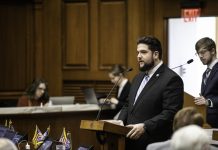By Victoria Ratliff
TheStatehouseFile.com
INDIANAPOLIS—State Rep. Ron Bacon and his wife, Karen, were at a dance when a fellow student collapsed in front of them..
Ron Bacon is a  Respiratory Therapist knew what to do. He and  a good friend and nurse Jessica Schnur performed CPR for the next 14 minutes while waiting for an ambulance to arrive. The patient survived.
Other victims of a sudden cardiac event often aren’t as lucky. Bystanders, friends or family who call 9-1-1as lucky. Bystanders, friends or family who call 9-1-1 either do not know CPR, or in the state of shock, forget what to do. They often rely on the help of 9-1-1 operators to guide them through CPR.
But their 9-1-1 operator might not how to perform CPR either.
That’s changing because of a law that passed the General Assembly in the 2019 session requiring all 9-1-1 operators across Indiana to be certified in Telephone CPR (T-CPR).
Bacon, a Republican from Chandler, wrote the legislation after the American Heart Association reached out to get his help to add the training requirement.
House Enrolled Act 1342 not only requires the training for new and existing operators, but they must renew their skills every two years.
Bacon said through his time as a respiratory therapist and in his personal life he has seen how CPR can save lives.
“CPR is important to me because it’s been a part of my career,†he said.
Gov. Eric Holcomb signed the legislation on April 18. Current 9-1-1 operators must complete the training by July 1, 2020, and new employees will go through training during their first few weeks of employment.
Danielle Patterson, government relations director for the American Heart Association, said the bill will significantly increase the chances of surviving cardiac arrest.
In many rural areas, where ambulances can take upwards of 15 minutes to arrive, every minute can make the difference between life and death. Patterson noted that there are urban areas across the state that also lack good ambulances services.
Patterson told the House Veterans Affairs and Public Safety Committee, where the bill was being heard in February, of the importance of the CPR training. She testified that for every minute a cardiac arrest patient goes without CPR, their survival rate decreases by 10 percent.
“Our goal is to strengthen the system of care that’s already in place,†she said.
If an ambulance takes 10 minutes to arrive at the scene, as it does in many areas of Indiana, the patients’ chances of survival diminishes.
Chris McNamara of Indianapolis told the same committee that her husband, Shawn, might not be alive if the 9-1-1 operator hadn’t been able to walk her through performing CPR. Her husband went into ventricular fibrillation, also known as the ‘widow-maker’ because of its low survival rate, while at home in 2016.
“The doctor said that CPR saved Shawn’s life,†she said. Fewer than 10% of patients who go into ventricular fibrillation with treatment such as CPR will survive. Without treatment, the survival rate is only 5%.
Shawn not only lived, but because of the 9-1-1 operator’s ability to direct McNamara, he suffered no brain damage and only needed two weeks of physical therapy after coming out of his induced coma.
9-1-1 operators in Hamilton County already receive instruction on how to administer CPR by telephone as part of their Emergency Medical Dispatch training, said Jeff Schemmer, executive director of the county’s Public Safety Communications.
In EMD, 9-1-1 operators are trained on several medical scenarios where they will have to guide a person on the other end of the line through a potentially life-saving procedure before medics arrive. Another one is how to deliver a baby.
“Hamilton County has been participating in EMD for at least 20 years,†he said.
Although the changes won’t be drastic for Hamilton County and other counties like it, Schemmer thinks that having it as a requirement will still be beneficial.
Footnote: Victoria Ratliff is a reporter for TheStatehouseFile.com, a news website powered by Franklin College journalism students.
Editor’s Note: This is the first in an occasional series about the impact of legislation passed in the 2019 session of the Indiana General Assembly.






I would like to correct this story. My wife & I were at a dance in Evansville, not a dance class. My wife and I are not Physicians. I am a Respiratory Therapist. My wife was not the person who assisted in CPR, it was our good friend and Nurse Jessica Schnur. I do not fault the COO for these errors but “Statehouse Files” reporter apparently took bad notes that day.
I would like to thank the COO for printing this story. Performing Hands Only CPR can be lifesaving.
Ron
Article has been corrected. Thanks for your input and kind words.
Thank you for representing the people in your District in a professional and effective manner.
Regards,
CCO Editor
The story does not have any comments from 911 operators. Were any 911 dispatchers allowed to testify before the committees? Is there an penalty if the 911 operators do not give CPR instructions? Out of the 92 counties in the state of Indiana how many 911 operators are on duty at one time. Im sure in Vanderburgh and Marion counties there are probably more than one dispatcher. How many counties have one person answering the phones,dispatching police,fire, or ems? It would not be possible for the dispatcher to give CPR info on the telephone in these counties. Also in most cases the fire departments are dispatched to medical calls also.
Its a great idea and we all like saving lives but not all of Indiana is like Evansville or Indianapolis with large dispatch centers.
More places should have AED (Automatic Electronic Defib) available.
Comments are closed.